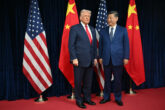February 25, 2020
Why Doesn’t the U.S. Have Its Own Huawei?
The Trump administration has tried one tactic after another to confront the rise of Huawei, the Chinese company that has been fighting to establish a dominant position in 5G. To date, American attempts to browbeat allies and partners into shunning the company’s equipment have proved ineffective. When it comes to countering Huawei’s dominance, White House officials have offered a disorganized assortment of options to respond, and often muddled the messaging.
In the process, there is one major question that Washington still hasn’t directly confronted: Why doesn’t the United States have its own homegrown competitor?
There are American companies that create the chips crucial to 5G; American phone carriers are competing to build out new 5G networks; and many American consumers are likely to have 5G service sooner than most, but more slowly than their counterparts in China and South Korea. But only two companies are currently competitive with Huawei in building the crucial infrastructure of the 5G network, and both of those are European: Ericsson and Nokia. These are the firms that make the crucial back-end equipment that enables 5G networks, known as the “radio access networks” (RAN), which is critical to transmitting data among the core network and user equipment.
Read the full article in POLITICO.
More from CNAS
-
Technology & National Security
Securing Our 5G FutureElsa B. Kania examines Washington and Beijing’s approaches to 5G development and proposes an American strategy for 5G security....
By Elsa B. Kania
-
Indo-Pacific Security / Energy, Economics & Security
How to Win the Economic War with ChinaTrump's approach to China has run aground, giving Beijing unprecedented advantage in the economic conflict....
By Edward Fishman & Julian Gewirtz
-
America’s Self-Loathing Is a Losing Hand
This article was originally published in The Washington Post.Around 10 years ago, the United States began a historic shift in its grand strategy toward China, abandoning the b...
By David Feith
-
Indo-Pacific Security / Energy, Economics & Security / Technology & National Security
Selling AI Chips Won’t Keep China Hooked on U.S. TechnologyU.S. policy should not rest on the illusion that selling chips can trap China inside the American tech ecosystem....
By Janet Egan




